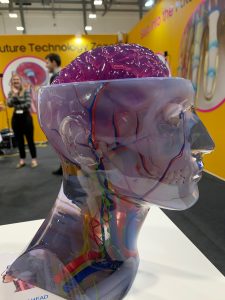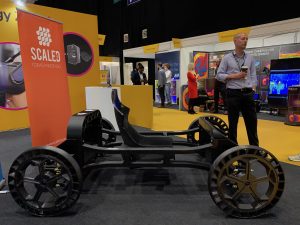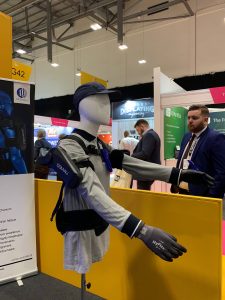The Engineering Design Show in the Coventry Ricoh Arena last week provided a great opportunity for Design academics Nicole Lotz and Georgy Holden to see companies showing state-of-the-art design engineering as well as to meet with one of our new design students.
A strong theme in the show was 3D printing. This ranged from day to day fusion deposition printers for the home or small office, enabling high finish printing of parts or concepts, through to multi-coloured 3D printing and a 3D printed car chassis. The use of 3D print for medical uses was identified as a steadily growing area, for example enabling surgeons to rehearse for operations. A more unusual use seen was an unbreakable electric guitar, with a 3D printed body. The body of the guitar was made using laser sintering of titanium powder with a hand milled and integrated neck. Swedish rock musician Yngwie Malmsteen, known for destruction of guitars, failed to break it but did succeed in smashing an amplifier in the attempt. The advances in materials available for printing and the developing use of 3D printing for manufacturing as well as prototyping are indicative of a technology that is moving from a radical innovation to an established innovation.


Another interesting innovation which we were fortunate to try, was an exo-skeleton, designed to reduce upper body fatigue and improve posture when lifting. Strapping on the exo-skeleton was much like putting on a rucksack, adjustments on the hip straps ensure that the fit is right for the wearer. The arm units, containing the springs, strap around the upper arms. Once in place the arms feel almost as if they are in zero gravity. Reaching to lift something from the floor necessitates bending the knees and lifting as all procedures advise as the stiff back brace prevents incorrect bending. The company showing this claim that with this on workers suffer 30% less fatigue. The exoskeleton is seen as having uses in multiple sectors, from warehouses to the NHS. The benefits of reduced fatigue and correct postures could be very positive for workers and employers alike if sickness absence is reduced. However, there could be ethical issues if this was used to make people work for longer rather than protecting their wellbeing.

In addition to the stands, we also attended two talks at the show. The first, led by the Design Council, UK Innovate and a representative of the IET (Institution of Engineering and Technology) was an introduction to the UK strategic priority of design for ageing. The themes of inclusive design and design for users will be familiar to OU design students as they have been an integral part of our teaching for a long time, though they are perhaps newer ideas for some engineers. The second talk, by a representative of the software company Altair used the example of Brompton, the bicycle company, using simulation software, based on finite element analysis, to test, create and optimise new designs. Tests that would, traditionally be run on prototypes in test rigs over a number of weeks can now be completed in minutes on 3D drawings. Optimising designs in this way is also leading to stronger, more organic looking components which better handle the stresses, strains and loads that are applied. The advantages of simulation are huge, saving time and money both through faster testing but also because optimising designs leads to savings in materials. Though this approach has been used for some years now, (and is shown in OU design materials) the combination of simulation alongside the use of 3D printing means that viable prototypes can quickly be created and physical models evaluated.

Leave a Reply